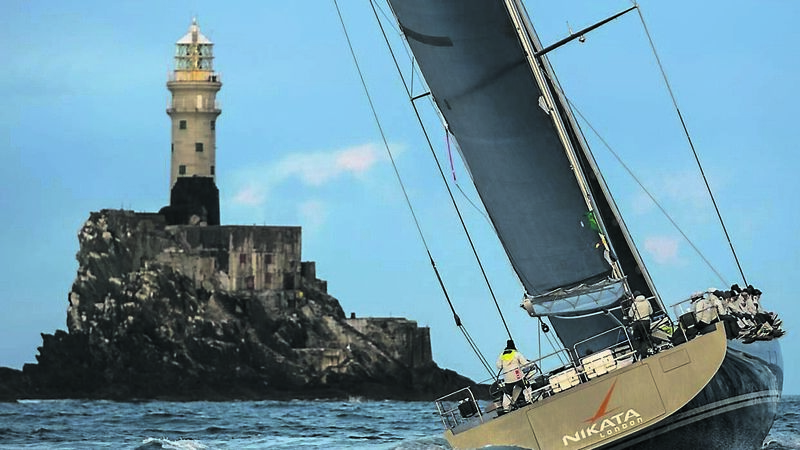Glory and tragedy... 100 years of Fastnet Race highs and lows

But there is a strong case to be made that the most iconic of all lies eight miles off the Cork coast, out in the wild Atlantic.
The lighthouse on Fastnet Rock has withstood the most extreme conditions Mother Nature can lash at it for 121 years, and was described by The Economist as “a monument of man’s gift to mankind”.
The place is awash with history - the most southerly tip of Ireland, the Rock was usually the last sight of the homeland by emigrants heading to America - and thus dubbed ‘Ireland’s teardrop’.
Despite its remoteness, - Fastnet comes from the Irish for ‘lonely rock’ - the stone lighthouse here is a feat of engineering, and remains the tallest and widest anywhere in Ireland or Britain.
The remarkable dot in the ocean is about to come into sharper focus, as the biennial Fastnet Race starts today, involving 470 yachts.
These vessels and their hardy crew will set off from the Isle of Wight on a 700-mile race that uses the Fastnet as a turning point, before the yachts head back to the finishing line in England or, in latter years, Cherbourg in France.
Remarkably, the winner that year is still afloat. Jolie Brise won the event a record three times in total, as well as winning a Tall Ships Race, and during her charmed life has changed hands at least ten times and survived a fire on board. Presumably, La Jolie Brise restaurant in Baltimore is named in her honour.
Those early races took six days to complete - these days, thanks to modern technology it is all over in just over 30 hours!
Fittingly, a Cork man’s yacht was the first to reach the Fastnet in that 1925 race, Harry Donegan’s Gull eventually coming in third.
A year later, Gull entered again but began to leak badly during a storm and limped into Cork Harbour. An American journalist on board reflected that “she was sailed by a pack of wild Irishmen who flogged the life out of her”.
Mr Donegan, a solicitor on the South Mall, was the first of four generations of the same family to complete the Fastnet race - followed by Brendan, Jim, and Peter.
As for the Gull, Harry Donegan eventually sold it to an English lawyer and set off from Crosshaven to deliver it to him in Dublin on the day World War II ended in 1945.
Harry waved him away and left him to be picked up by someone else while he sailed off to his rendezvous.
Tragically, he drowned two years later when his yacht overturned in Dun Laoghaire. His son Brendan, a seven-year-old at the time, wrote a memorable article in the 2010 Holly Bough about his death, and how he eventually overcame a fear of water and discovered a love for yachting in later life.
Tragedy also famously struck the Fastnet Race in 1979, when a storm caused devastation. At least 75 boats capsized and 15 competitors died, along with six observers who were aboard yachts shadowing the fleet.
Among those observers who made it to a safe harbour on Cape Clear were former Echo and Examiner owner Ted Crosbie - a keen sailor - and photographer Mick Olney. When the storm abated, they raced to Crosshaven to deliver the photographic reels depicting the unfolding tragedy.
The race that year was won by American media mogul Ted Turner, founder of CNN and one-time husband of Jane Fonda.
Notwithstanding that tragedy, the Fastnet Race remains a force for good for Cork and Ireland. In 1975, on the 50th anniversary of the event, leading Irish yachting writer, W.M. Nixon, stated: “For many in the world’s international offshore racing community, the Fastnet Rock is all they know of Ireland.”
That may well still be the case today.
In 1985, the largest wave ever recorded off Ireland’s seas was witnessed from the lighthouse.
Former keeper Dick O’Driscoll was working in the landmark when a freak wave reached as high as the light and came crashing through the glass, overturning a vat of mercury and sending the poisonous liquid pouring down the stairs.
The monster wave must have measured 157ft, or 48 metres, about the height of a 14-storey building, to do that damage - although the exact height remains unverifiable and the highest official wave off Ireland is a relatively puny 98ft (30 metre) effort recorded by a computerised buoy off the west coast during a hurricane in 2020. Imagine a wave crashing two-thirds of the way up the Elysian from sea level, and you get some idea of that freak of nature out at the Fastnet 40 years ago.
The mysteries of the ocean know no bounds.
Another Fastnet keeper once said that “big seas would come sailing over the entire building like the field of horses in the Grand National”.
Paul Barron, an electronic engineer with Irish Lights, had a bird’s eye view of Storm Barra from the Fastnet lighthouse in 2021, and reported: “It is extremely noisy during the squalls, so much so it is hard to talk. During the height of the storm, the entire tower seems to shudder a small bit. All that stood between me and the elements were little panes of glass. But the structure is incredibly strong as the granite stones that were used were all keyed together like a giant jigsaw. And I’m sure it has survived bigger storms and events than this!”
Only two Irish men have won the Fastnet race - Stephen Fein in 1987 and Limerick’s Ger O’Rourke in 2007.
Former Cork Examiner sailing correspondent Tom O’Sullivan has called it “the Everest for sailors with a glamour akin to Formula 1”.
“Skipper beckoned for a gin,” recalled Tom, “to which I replied, ‘It’s 6am!’ Ted paused briefly and shouted: “Tom, break out the gin, the sun is over the yardarm in Australia.”







 App?
App?




